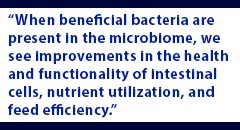
Managing the microbiome (part 1): What affects the balance?
 By Dr. Michaela Trudeau
By Dr. Michaela Trudeau
Millions of microbes – including bacteria, protozoa, viruses and fungi – reside in the intestinal tract of pigs and collectively play a role in nutrient digestion, pathogen protection, immune function, and gut health. This large community comprises what is often referred to as the intestinal microbiome. In general, the microbes comprising the microbiome have a beneficial relationship with the pig and pig performance, but, if disrupted, pathogenic bacteria can overpopulate and negatively impact pig performance.
While still not completely understood, the composition of the intestinal microbiome has been correlated with growth performance, animal health and even behavior. Bacteria in the microbiome constantly produce metabolites and byproducts, which are used to communicate with other biological systems in the pig. For example, some bacteria produce neurotransmitters that alter cell activity in the brain. Other bacteria can ferment fiber and produce short-chain fatty acids, which are an energy source for the pig. Overall, the microbiome is correlated to many biological activities in the pig and understanding its function can be used to increase productivity.
The core intestinal microbiome of a pig is relatively the same throughout its lifetime. The microbiome is made up of thousands of species, but mainly consists of only a few different phyla of bacteria, each of which differs in proportion based on location within the gut.
Factors impacting microbiome populations
Many factors significantly alter the microbiome. While this list is not comprehensive, the following five areas may have the greatest impact on the microbiome of pigs, regardless of stage of production.
- Diet: Populations of bacteria present in the microbiome will shift based on the diet fed to the pig. For example, the bacterial genera Prevotella and Ruminococcus ferment fiber present in plant-based diets. For this reason, when piglets are weaned and transition from a milk-based diet to a plant-based diet, there will be an increase in the abundance of Prevotella and Ruminococcus in the microbiome to help them digest the plant-based feed.
Because the microbiome is adapted to the diet an animal is eating, dramatic and sudden changes in diet composition could create stress and imbalance in the microbiome. For example, the greater the difference between gestation and lactation diets, the greater the impact on the sow’s microbiome during that transition.
 Feeding patterns: Feeding and fasting cycles also play a role in microbiome composition. During fasting periods, intestinal bacteria do not have nutrients available and will instead consume the mucin layer in the pig’s intestine. The longer this fasting period continues, the greater the risk for developing a shift in the microbiome that favors harmful bacteria that break down the pig’s intestine. This type of shift in the microbiome could then potentially cause the animal to be less efficient at digesting and utilizing feed ingredients when the fasting period ends. Therefore, to help maintain an efficient microbiome, periods of long fasting should be avoided as much as possible.
Feeding patterns: Feeding and fasting cycles also play a role in microbiome composition. During fasting periods, intestinal bacteria do not have nutrients available and will instead consume the mucin layer in the pig’s intestine. The longer this fasting period continues, the greater the risk for developing a shift in the microbiome that favors harmful bacteria that break down the pig’s intestine. This type of shift in the microbiome could then potentially cause the animal to be less efficient at digesting and utilizing feed ingredients when the fasting period ends. Therefore, to help maintain an efficient microbiome, periods of long fasting should be avoided as much as possible.- Stress: When an animal is stressed, it produces the hormone cortisol. When cortisol levels increase in circulation, it creates a shift in the microbiome and, ultimately, puts the pig at greater risk for a list of diseases.
Typically, a major stressor event that impacts the pig both in the short- and long-term is weaning. Weaning greatly impacts the microbiome, leading to a larger concentration of negative bacteria and reducing the beneficial bacteria that the pig relies on.
Additionally, moving or relocating sows, out-of-feed events, vaccinations, and farrowing all may add significant stress to animals. Upon birth, piglets are born with a very limited microbiome. As such, while very early life care and processing are necessary activities, the less stress placed on young piglets, the better.
- Disease pressure: As a pig is exposed to additional pathogens, it provides more opportunities for negative microbes to colonize within the gastrointestinal tract, thus negatively impacting the microbiome. Knowing what diseases are present in each barn setting helps identify the best ways to manage disease pressure and minimize the negative impacts they have on your herd.
- Environment: Both within the same system and across different systems, the microbes present in the environment can greatly vary. All pigs have a similar core microbiome, but unique environments may slightly alter the microbiome from one location to the next. These variations in the microbiome can be attributed to a pig’s exposure to bacteria in the environment early in life and even slight differences in the rearing environment can have a significant impact on the microbiome.
Editor’s note: In part 2 of this series, we will explore nutritional strategies to maintain a healthy microbiome.
About the author: Dr. Michaela Trudeau joined Vita Plus as a swine nutritionist in October 2020. She grew up in Minnesota and attended the University of Minnesota to receive her bachelor’s degree in animal science with honors. Trudeau continued her education at the University of Minnesota and received a master’s degree in animal science. Her master’s thesis focused on the persistence of porcine coronaviruses in feed and feed ingredients. In December 2020, Trudeau received her Ph.D. in animal science at the University of Minnesota, where her research focused on understanding the mechanisms of growth responses to various antibiotic alternatives in nursery pigs.
| Category: |
Animal handling Animal health Feed ingredients Feed quality and nutrition Swine Performance |

